The Dukes of Lancaster
Edmund Crouchback, 1st Earl of Lancaster (16 January 1245 5 June 1296)
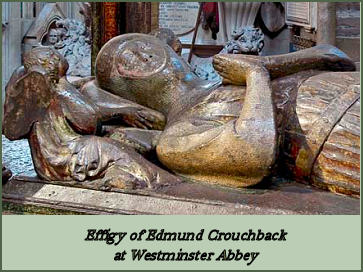 Edmund Crouchback was the second son of King Henry III and Eleanor of Provence and was born in London on 16th January, 1245.
Edmund Crouchback was the second son of King Henry III and Eleanor of Provence and was born in London on 16th January, 1245.
In 1252, when he was 10 years old, Pope Innocent IV nominated him as King of Sicily but he never took possession of the kingdom. Following the defeat and death of of Simon de Montfort, 6th Earl of Leicester at the Battle of Evesham in 1265, Edmund was created Earl of Lancaster and Leicester and granted de Montfort's estates.
In 1271 he accompanied his elder brother, the future King Edward I, on the Ninth Crusade. His nickname of Crouchback (or crossed back) probably originated from the surcoat with a cross on the back worn by Crusaders. but the name was later misunderstood, and later gave rise to the belief that he was physically deformed. His descendant Henry IV later sought to justify his usurpation of the throne by claiming that Edmund had actually been the first son of Henry III, but that he was overlooked in favour of his 'younger' brother Edward I because of this deformity.
On his return to England he made Grosmont Castle in Monmouthshire his home and carried out much rebuilding there. He fought in the Welsh wars against Llywelyn and Davydd ap Gruffedd (1282-83); and played a role in diplomacy in France.
Edmund was married twice, firstly to Aveline de Forz, the daughter of William de Forz, 4th Earl of Albemarle and Isabella de Fortibus, Countess of Devon. She died at the age of 15, just 4 years later. There were no children from the marriage. Edmund later married again to Blanche of Artois, widow of Henri I, King of Navarre, and a grand-daughter of Louis VIII, king of France. The marriage produced 3 sons, Thomas, 2nd Earl of Lancaster, Henry 3rd Earl of Lancaster, John, Lord of Beaufort and a daughter, Mary.
Edmund died at Bayonne while besieging Bordeaux for his brother Edward I, on 5 June 1296 and was buried at Westminster Abbey.
Thomas, 2nd Earl of Lancaster (circa 1278 22 March 1322)
Thomas Plantagenet, the eldest son of Edmund Crouchback, 1st Earl of Lancaster and Blanche of Artois suceeded his father as Earl of Lancaster in 1296. By his marriage to Alice de Lacy, Countess of Lincoln, the daughter of Henry de Lacy, 3rd Earl of Lincoln, he became Earl of Lincoln, Earl of Salisbury, 11th Baron of Halton and 7th Lord of Bowland upon the death of his father-in-law in 1311.
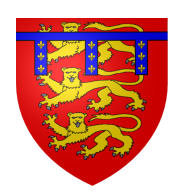 In 1317 Alice de Lacy was abducted from her manor at Canford in Dorset by Richard de St Martin, a knight in the service of John de Warenne, 7th Earl of Surrey. The abduction resulted in a feud between Lancaster and Surrey; Thomas retaliated by divorcing Alice and seizing two of Surrey's castles. King Edward I intervened in the quarrel and the two Earls came to an uneasy truce.
In 1317 Alice de Lacy was abducted from her manor at Canford in Dorset by Richard de St Martin, a knight in the service of John de Warenne, 7th Earl of Surrey. The abduction resulted in a feud between Lancaster and Surrey; Thomas retaliated by divorcing Alice and seizing two of Surrey's castles. King Edward I intervened in the quarrel and the two Earls came to an uneasy truce.
He played a part at the coronation of his cousin, Edward II, in February 1308, during which he carried Curtana, the sword of St Edward the Confessor. Edward II was in constant conflict with his nobles, the royal favourite, Piers Gaveston, was highly unpopular, when Gaveston insisted that Edward dismiss one of his retainers, he swore revenge for the insult. Thomas became one of the Lords Ordainers who demanded the banishment of Gaveston and the establishment of a Baronial oligarchy, he helped separate the King from his favourite and was one of the judges who convicted Gaveston and sentenced him to be executed. Following the disaster at Bannockburn in 1314, a resounding Scots victory over the English, Edward was forced to submit to his cousin Thomas, who became virtulal ruler of England.Edward was never to forgive his cousin for Piers Gaveston's death.
During the next four years, he was unable to prevent the Scots from raiding and recapturing land in the North resulting in him being deposed from office. The new leadership was eventually headed by the hated Hugh le Despenser, 1st Earl of Winchester and his son Hugh the younger Despenser, another of Edward's favourites. Thomas led a rebellion against them in 1321, but was was defeated at the Battle of Boroughbridge, and taken prisoner. He was put on trial in the great hall of his own castle at Kenilworth, by a tribunal which included the two Despensers, the result was a foregone conclusion, Thomas was not allowed to speak in his own defence as his crimes were deemed 'notorious', The list of charges comprised the many smouldering grievances Edward held against Thomas and he was sentenced to death by hanging, drawing and quartering, though Edward commuted the sentence to mere beheading. He was executed outside Pontefract Castle.
Henry, 3rd Earl of Lancaster (circa. 1281 22 September 1345)
Upon the death of Thomas, 2nd Earl of Lancaster, in 1322 his titles and estates were forfeited, but in 1323 his younger brother Henry, who did not participate in Thomas' rebellions, successfully petitioned for the return of the Earldom of Leicester, and in 1326 or 1327 Parliament posthumously reversed Thomas's conviction, and Henry was given back the Earldoms of Lancaster, Derby, Salisbury and Lincoln.
Henry married Maud Chaworth, daughter of Patrick De Chaworth and Isabel De Beauchamp, before 2 March 1296/1297, the marriage produced 7 children, Henry, Earl of Derby and 6 daughters.
Edward II's slighted Queen, Isabella, known as the 'She Wolf of France', deeply insulted by her husband's preference for male favourites, landed in England with an army in September 1326, accompanied by her lover, Roger Mortimer, 1st Earl of March. Henry joined forces with her against his cousin King Edward II, which led to the capture and execution of Hugh le Despenser, 1st Earl of Winchester, and his son Hugh the younger Despenser. He was dipatched to pursue the king, who had fled, he captured him at Neath in South Wales. Henry then held the king in his custody at Kenilworth Castle and was appointed "chief advisor" for the young King Edward III. On 3rd April, 1327. Edward was removed from Kenilworth and later imprisoned at Berkeley Castle in Gloucestershire where, it was generally believed, he was murdered by an agent of Isabella and Mortimer on 11 October 1327. In 1328 Henry refused to attend Parliament and quarrelled with the Queen, who then attacked and laid waste to his lands in Leicester. Henry attempted to fight the Queen and Mortimer's troops, but was forced to submit to them, and his lands were returned to him.
The young Edward III grew to resent the influence of Mortimer and aided by Henry and several of his lords, he led a coup d'etat to remove Mortimer from power. The Dowager Queen's lover was arrested at Nottingham Castle. Stripped of his land and titles, Mortimer was accused of assuming Royal authority. Isabella's pleas for her son to show mercy were ignored. Without the benefit of a trial, Mortimer was sentenced to death and executed at Tyburn. Isabella herself was shut up at Castle Rising in Norfolk
After the fall of Isabella and Mortimer, Henry was able to resume his close friendship with the young King. He died on 22nd September 1345 and was buried at Newark Abbey in Leicester.
Henry of Grosmont, 1st Duke of Lancaster, (circa 1310 23 March 1361)
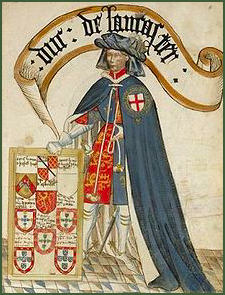 Henry, 1st Duke of Lancaster, perhaps the most distinguished member of the elder House of Lancaster, was the only son of Henry, 3rd Earl of Lancaster, and Maud Chaworth, was born at Grosmont Castle in the Welsh Marches, in around 1310. According to his own memoirs, he was better at martial arts than at academic subjects, and did not learn to read until later in life.
Henry, 1st Duke of Lancaster, perhaps the most distinguished member of the elder House of Lancaster, was the only son of Henry, 3rd Earl of Lancaster, and Maud Chaworth, was born at Grosmont Castle in the Welsh Marches, in around 1310. According to his own memoirs, he was better at martial arts than at academic subjects, and did not learn to read until later in life.
He married Isabella, the daughter of Henry, Lord Beaumont, in 1330. The marriage produced two daughters: Maud (born 1339) and Blanche (born 1345). Maud was married to William I, Duke of Bavaria, while Blanche married Edward III's third son John of Gaunt.
Much is known about his personality, due to a devotional treatise he wrote in 1354, the Livre de Seyntz Medicineswhere he recorded he enjoyed dancing, hunting, women, fine clothes and good food and found it hard to get up in the morning when he 'should have been enthusiastic to rise and serve God.' Henry's first military encounter appears to have been in the Scottish expedition in 1336. At the outbreak of the Hundred Years' War in 1337, he took part the Battle of Sluys, a great naval victory in 1340. Later that year, he was commited as a hostage in the Low Countries for the king's considerable debts. He remained hostage until the following year and was required pay a large ransom for his release. On his return to England he was appointed the king's lieutenant in the north and stayed at Roxburgh until 1342.
Edward III planned a major assault on France in 1345 in the form of a three-pronged attack in which the Earl of Northampton attacked from Brittany, the king from Flanders, while Henry was dispatched to Aquitaine, he won a victory against the Comte dIsle at Auberoche on 21st of October. The following year he laid siege to, and captured, Poitiers. While he was in France, his father died at Leicester and he succeeded to the Earldom of Lancaster.
After he had taken part in the Siege of Calais in 1347, he was appointed as a founding knight of the Order of the Garter by his second cousin, the king, in 1348. In 1351, he was created Duke of Lancaster, the second dukedom ever created in England. In 1350 he fought at the naval Battle of Winchelsea, where, it is said, he saved the lives of the Black Prince and John of Gaunt, the sons of Edward III, by attacking the huge Spanish ship that had engaged the Prince's.
In 1351-2 Henry went on crusade in Prussia. During which a bitter quarrel with Otto, Duke of Brunswick, led to a duel being arranged between the two men. An enthusiastic jouster, Henry had a formidable reputation in the lists. Early in his career he had vanquished and badly wounded Sir William Douglas of Liddlesdale, Scotland's ‘flower of chivalry'. On the appointed day both entered the lists, but the Duke of Brunswick's face is said to have suddenly become pale, he trembled violently and his arm became so weak that he could not lift his sword, he then submitted himself to the arbitration of the King of France, John II, who reconciled the enemies.
After the siege of Rennes in 1358, he participated in the last great offensive of the first phase of the Hundred Years' War, the Rheims campaign of 1359-60. After returning to England in November 1360, he fell ill early the next year, and died at Leicester Castle on 23 March. It is likely that the cause of death was the plague, which that year was making a second visitation of England. He was buried at the Collegiate Church in Newark, in Nottinghamshire.
John of Gaunt, Duke of Lancaster
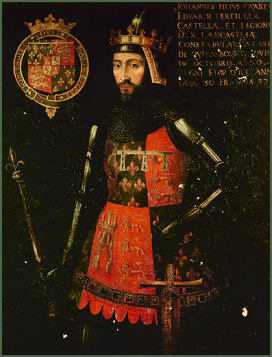 John of Gaunt, Shakespeare's 'Time honoured Lancaster' was the third surviving son of Edward III and Phillipa of Hainault, he was born on 6th March 1340 at Ghent, which was then in Flanders. The name of his birthplace was Anglisized to Gaunt.
John of Gaunt, Shakespeare's 'Time honoured Lancaster' was the third surviving son of Edward III and Phillipa of Hainault, he was born on 6th March 1340 at Ghent, which was then in Flanders. The name of his birthplace was Anglisized to Gaunt.
His first wife, Blanche of Lancaster, was his third cousin, both being great great grandchildren of King Henry III. They were married in 1359 at Reading Abbey. On the death of his father-in-law, Henry of Grosmont, in 1361, John was granted half his lands, the title "Earl of Lancaster", and the distinction as the greatest landowner in the north of England. He also became the 14th Baron of Halton and 11th Lord of Bowland. When Henry of Grosmont's elder daughter Maud, died childless on 10th April 1362, soon after her marriage, John inherited the rest of Grosmont's estates. He was created Duke of Lancaster by his father on 13th November, 1362.
John's first child was an illegitimate daughter, Blanche (1359-1388/89). Blanche was the daughter of John's mistress Marie de St. Hilaire of Hainaut who was a lady-in-waiting to his mother, Queen Philippa. The marriage to Blanche produced Henry Bolingbroke who later became Henry IV and Philippa, who became Queen of Portugal by marriage to King John I of Portugal in 1387. Through this marriage all subsequent kings of Portugal are descended from John of Gaunt. Another daughter Elizabeth (13641426), married firstly in 1380 to John Hastings, 3rd Earl of Pembroke (13721389), this marriage was annulled in 1383 and she later married John Holland, 1st Duke of Exeter in 1386 and finally Sir John Cornwall, 1st Baron Fanhope and Milbroke. Two other sons, Edward (born in 1365) and John (born 1366) died in infancy.
John campaigned with his elder brother Edward of Woodstock, known as the Black Prince and participated in many of the battles of the Hundred Years War and in aid of his ally Pedro the Cruel of Castile. After Blanche of Lancaster died of bubonic plague on 12th September 1369 at Bolingbroke Castle, he married Pedros daughter Costanza of Castille, through whom he laid claim to the throne of Castile. As his father declined in health in his later years, John allied himself with the corrupt court party led by Alice Perrers, the aging king's mistress and thereby gained control of England. He was temporarily dislodged from power by the Good Parliament of 1376, but John was soon able to restore his friends and assembled a hand-picked Parliament in 1377. Hostility to the strong clerical party, led by William of Wykeham, caused him to support the movement of the religious reformer John Wyclif. Since the Black Prince predeceased his father, the king was succeeded by his grandson, Richard II and during his nephew's minority, Gaunt became virtual ruler of England.
The poet Geoffrey Chaucer, author of 'The Canterbury Tales' was a member of Gaunt's household, he made Chaucer's sister-in-law, Katherine Swynford, the daughter of a herald and widow of a knight, his mistress for many years, and married her after the death of Constance of Castille. After the marriage, his illegitimate children with Katherine were later made legitimate by Richard II and by papal decree but they were barred from inheriting the throne. The eldest son of their union was John Beaufort, 1st Earl of Somerset (1373–1410), whose granddaughter, Margaret Beaufort, was the mother of Henry VII, the first Tudor King of England. Their other children where Henry, Cardinal Beaufort, (13751447), Thomas Beaufort, Duke of Exeter (13771426) and Joan Beaufort, Countess of Westmorland (13791440), who was the maternal grandmother of Edward IV and Richard III.
In 1386 Gaunt launched a campaign into Castille, allied to the Portuguese, the Castillians retreated before him, burning and destroying what they could not carry away. The campaign foundered as the troops succumbed to privation, dysentery, and plague, putting an end to his personal ambitions in Spain. A marriage was arranged between Henry, the son of Juan of Castille and Catherine, John's daughter by Constance of Castille, which settled all rights and claims to the throne in that marriage.
John left Portugal for Aquitaine, where he remained until he returned to England in November of 1389. In his absence England endured the major political crisis of the conflict between Richard II and the Lords Appellant, who were led by Gaunt's younger brother Thomas of Woodstock, Duke of Gloucester. Four months after his return to England, in March 1390, Richard II formally invested Gaunt with the Duchy of Aquitaine. He raised no protest when his brother Thomas was murdered on Richard's orders. It is possible that he felt he had to maintain this posture of loyalty to protect his son Henry of Bolingbroke, who had also been one of the Lords Appellant, from the wrath of Richard, in 1398 Bolingbroke was exiled, and on John of Gaunt's death at Leicester Castle the next year he was disinherited, and Richard seized Gaunt's vast estates.
John of Gaunt was buried beside his first wife, Blanche of Lancaster, in the choir of St Paul's Cathedral.
Henry of Bolingbroke, Duke of Lancaster, later King Henry IV (3 April 1367 20 March 1413)
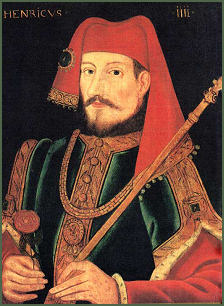 Henry Plantagenet was born at Bolingbroke Castle in around April 1366, he was the son of John of Gaunt and Blanche Plantagenet, in common with his first cousin, Richard II, he therefore had a double Plantagenet descent. Henry's mother, Blanche, Duchess of Lancaster was a beautiful and gracious woman, much admired by the poet Geoffrey Chaucer, who dedicated his Book of the Duchess to her.
Henry Plantagenet was born at Bolingbroke Castle in around April 1366, he was the son of John of Gaunt and Blanche Plantagenet, in common with his first cousin, Richard II, he therefore had a double Plantagenet descent. Henry's mother, Blanche, Duchess of Lancaster was a beautiful and gracious woman, much admired by the poet Geoffrey Chaucer, who dedicated his Book of the Duchess to her.
The young Bolingbroke was created a knight of the Garter by his grandfather, Edward III, on St.Georges Day 1377. At Richard II's coronation later that year, his seven year old cousin played a prominent part, holding the sword of mercy, Curtana. Henry grew to a short but stocky man with red-brown hair, a red beard and brown eyes. Courageous and energetic, in common with many of the Plantagenet family, he was fond of music and song.
Henry was married in childhood to Mary de Bohun, the daughter and heiress of the renowned Humphrey de Bohun, Earl of Hereford and in her right held that title. He was also held the Earldom of Derby. The marriage produced 7 children, Edward of Lancaster, who died in infancy, King Henry V, Thomas of Lancaster, 1st Duke of Clarence, John of Lancaster, 1st Duke of Bedford, Humphrey, 1st Duke of Gloucester, Blanche, Electress Palatine and Philippa, Queen of Denmark, Norway and Sweden.
Henry had supported his cousin Richard II against three of the Lords Appellant and accused the fifth Lord Appellant, Mowbray, of treason, A trial by combat was decided upon to settle the issue but Richard intervened, preventing the duel, and banishing Henry for ten years. He later confiscated his cousin's extensive estates and decreed the banishment should remain in force for life. On the death of his father in 1399, Henry landed at Ravenspur claiming he came to safeguard his inheritance, but actually came to take the throne from the cousin he now thoroughly detested. Landing at Ravenspur in Yorkshire, on the pretext of recovering his estates, but in reality he intended to seize his cousin's throne. Richard, in Ireland at the time, sailed to Wales. The King met Henry's representatives at Conway Castle and was informed that if he restored Henry's estates and surrendered certain councillors for trial, he could remain in power. He agreed but was betrayed and instead of being returned to power found himself the inhabitant of a dungeon in the Tower.
A Parliament was called at the end of September, at which Henry claimed the throne, at which point the Duchy of Lancaster merged in the crown. Richard was declared a tyrant and deposed. He was taken up to Pontefract Castle, in Yorkshire and there it is certain, he met his end around the second week in February, 1400. His skeleton was examined in 1871 by Dean Stanley of Westminster but showed no marks of violence. Starvation was the most likely cause of death, although this has never been proven.
Henry consolidated his position on the throne and quashed minor rebellions, but the revolt of Owen Glendower in 1400 proved a more serious challenge to his rule. In 1403, Glendower allied with Henry Percy, Earl of Northumberland, and his son Henry, called Hotspur. Hotspur's uprising ended when he was killed in battle near Shrewsbury in July 1403. Northumberland's rebellion was suppressed and was the last armed challenge to Henry's authority. However, he also had to fight off Scottish border raids and conflict with the French. To finance these activities, Henry was forced to rely on parliamentary grants. From 1401 to 1406 parliament repeatedly accused him of fiscal mismanagement and gradually acquired new powers over royal expenditures and appointments.
In the latter part of his reign Henry was struck by a disfiguring disease, which forced him to become a recluse. The Prince of Wales, who the king considered too eager to step into his shoes, was given control of the government along with a council. The king's health steadily deteriorated, he contracted a form of skin disease, variously considered to be leprosy, syphilis or psoriasis. The attacks he suffered from have been the subject of a wide range of theories which it is impossible to confirm, they range from epilepsy to a form of cardiovascular disease. Henry suffered a seizure whilst praying at St. Edward's shrine at Westminster and was carried to the to the abbot's house. The first King of the House of Lancaster died on 20th of March 1413, aged forty-six, in the Jerusalem chamber at Westminster.
He was not buried at Westminster, the traditional mausoleum of English kings, but at Canterbury Cathedral, in the Trinity Chapel, near to the shrine of Thomas A' Becket and opposite the tomb of the Black Prince. His widow, Joan of Brittany, had an altar tomb built over the spot.
The Lancastrian dynasty ruled England for three generations, encompassing the reign of Henry V, the conqueror of France, before the throne was taken from his son, the pious Henry VI, by the powerful rival House of York in 1461. The House of Lancaster became extinct in the direct male line on the death of Henry VI's only son, Edward of Lancaster, during or after the Battle of Tewksbury in 1471.
